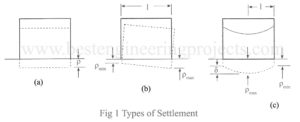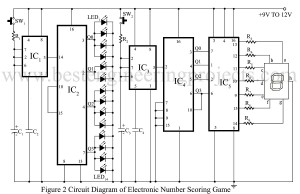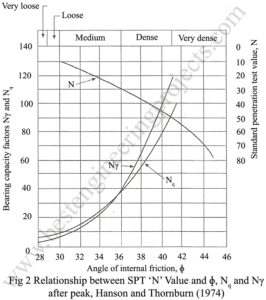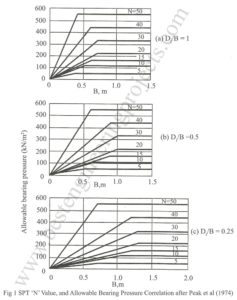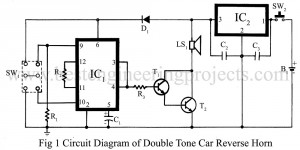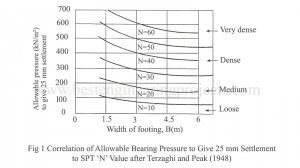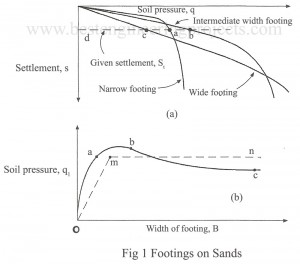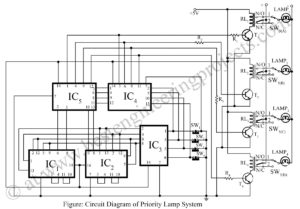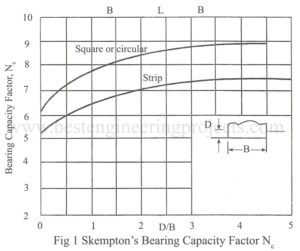Settlement is the vertical displacement from its original level of placement. Settlement has got several implications on a foundation. The implications include: Appearance of structures Utility of structures Damage to the structures Appearance of structures | Settlement of Foundation Settlement affects the appearance of structures. If a structure settles excessively, its aesthetic is impaired. It causes doors and windows to distort, walls and plasters to crack and the structure to tilt. Utility of Structures | Settlement of Foundation Settlement interfere the utility of structures in many ways. If settlement is excessive overhead…
Read MoreElectronics Number Scoring Game
We have already posted few interesting electronics game project. Now, here is one very interesting game projects “Electronics Number Scoring Game” which can give you hour of fun. You can play electronics number scoring game alone or with some friends. Circuit Description of Electronics Number Scoring Game The circuit of electronics number scoring game uses two timer ICs i.e. NE 555 (IC1 and IC3) to generate clock pulse and a decade counter to generate mathematical sign. A BCD counter followed by a seven-segment LED display driver is used to generate…
Read MoreTeng’s method | Meyerhof’s method | Bowles method for net safe bearing pressure
Teng’s method – Teng (1962) based on the work of Terzaghi and Peck gave a relationship for allowable bearing capacity for a given permissible settlement. The equation is: qns = 35(N-3){(B+0.3)/2B}2RWRd ———- (1) Where, qns = Net safe bearing pressure, kN/m2 N = SPT value corrected for overburden pressure RW = Water table correction factor Rd = Depth correction factor = 1 + 0.2Df/B ≤1.2 The above equation can also written in general form as: qns = 1.4(N-3){(B+0.3)/2B}RwRdS ———- (2) Where, S = Permissible settlement in mm. Meyerhof’s…
Read MoreModification of Teraghi and Peak Correlation by Peak, Hanson and Thornburn
Peck, Hanson and Thornburn (1974) | Modification of Teraghi and Peak Correlation by Peak, Hanson and Thornburn Peck, Hanson and Thornburn (1974) have modified the original Terzaghi and Peck (1948) recommendations and presented charts as shown in Fig.1 to obtain allowable bearing pressure to give a settlement of 25 mm for a footing of known width, B with its base at a depth, Df resting on a granular deposit in which N (corrected SPT) values are measured. Procedure | Modification of Teraghi and Peak Correlation by Peak, Hanson and Thornburn N (corrected…
Read MoreDouble tune Car Reverse Horn
Several circuits of musical car horn have been published in BEP but “Double tune car reverse horn” differs from them. Projects like this helps you to get more used to various electronic devices. The circuit that produces the double tune car reverse horn generates two types of sounds: one is a pleasant ‘ding-dong’ bell sound and the other one is a sweet chirping sound of a bird. Here, the IC HT82D (IC1) is used as the sound generator whose operating voltage range is 2 to 5 volts. It has 10…
Read MoreCorrelation between Corrected SPT(N) and pressure by Teraghi and Peak
Terzaghi and Peck (1948) were the first to propose a correlation between the N (corrected SPT) Value and allowed pressure, by presenting a relationship between the size of a footing, the N (corrected SPT) value, and the applied pressure to give a settlement of 25 mm for a deep ground water table, This correlation is shown in Fig.1 below. Procedure: N should not be corrected with respect to overburden. N should be averaged from the given values. The graph has been developed with the condition that the water table is…
Read MoreBearing Capacity from in Situ Tests
The computation of the bearing capacity from field plate load test has already been discussed in the chapter of site investigation. Here, the discussion will be limited to the estimation of bearing capacity from the results of standard penetration test. Cohesionless soil – In cohesionless soils, the bearing capacity is extremely high with respect to shear failure criteria. In sands, the shear failure criteria govern the capacity only in the case of very narrow footing located in loose sand below water table. In most of the cases the bearing capacity…
Read MorePriority Lamp Circuit
The circuit described here is a Priority Lamp Circuit which gives priority in switching. Switches SW1 to SW4 is a push-to-off type or push-button type, as desired. Normally, pushing off any switch will turn ‘on’ the corresponding relay, i.e. pushing of SW1 enables the NPN transistor T1, and hence relay RL1 operates. The logic section of is designed to get a controlled high output. The pressing of one switch disables the operation of all switches and results in priority in switching. In normal cases, all switches are closed and all relays…
Read MoreSkempton’s Theory for Cohesive Soil
Skempton 1951 suggested a bearing capacity theory for saturated clay for which ɸ = 0. Skempton gives Nc, the bearing capacity factor on the basis of theory, laboratory tests and field observations. It was found that the value of Nc increased with the increase in Df/B ratio. The expression for Nc proposed by Skempton is given below. For Strip footings, Nc = 5(1+0.2Df/B), with a maximum limiting value of 7.5 ———- (1) For square and circular footings, Nc = 6(1+0.2Df/B), with a maximum limiting value of 9.0 ———-…
Read MoreHansen’s Bearing Capacity Theory
Hansen 1970 proposed a general bearing capacity equation. This equation is widely used because the equation can be used for both shallow as well as deep foundation. Full scale test on footings has indicated that the Hansen equation gives better correlation than the Terzaghi’s equation. Terzaghi’s equation is known to give conservative results. However, it is still in wide use for its simplicity. The proposed form of the equation is: ———- (1) Table 1 Shape, Depth, load Inclination, Ground and Base Inclination factors. Use term with prime factor when Shape…
Read More